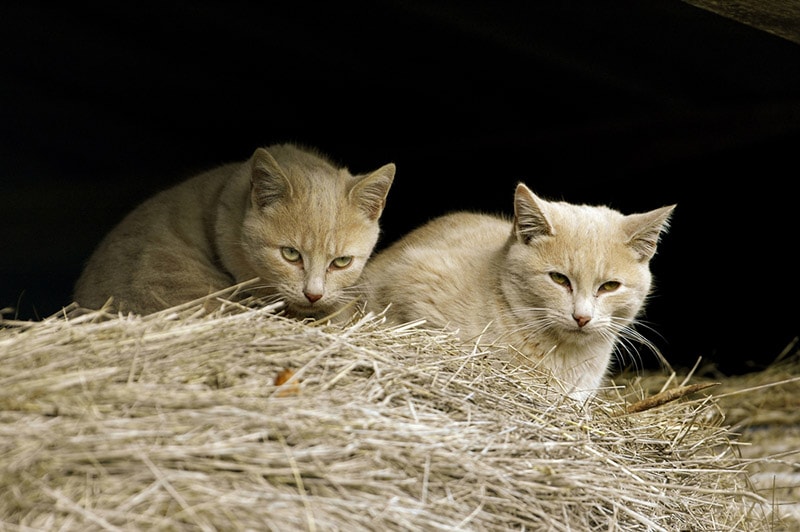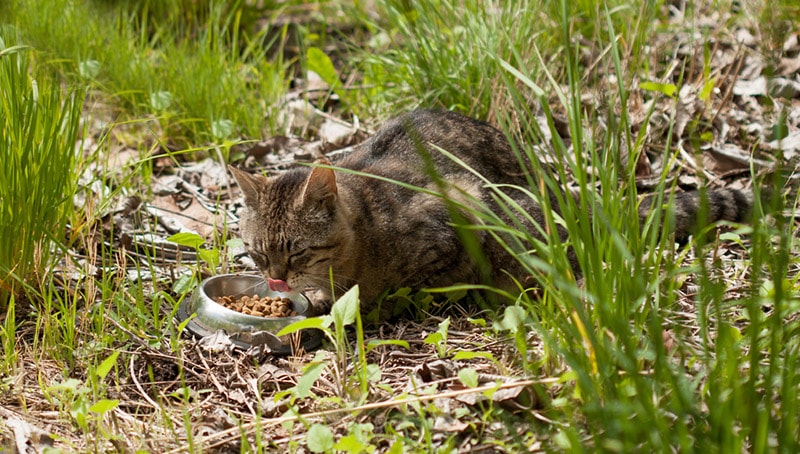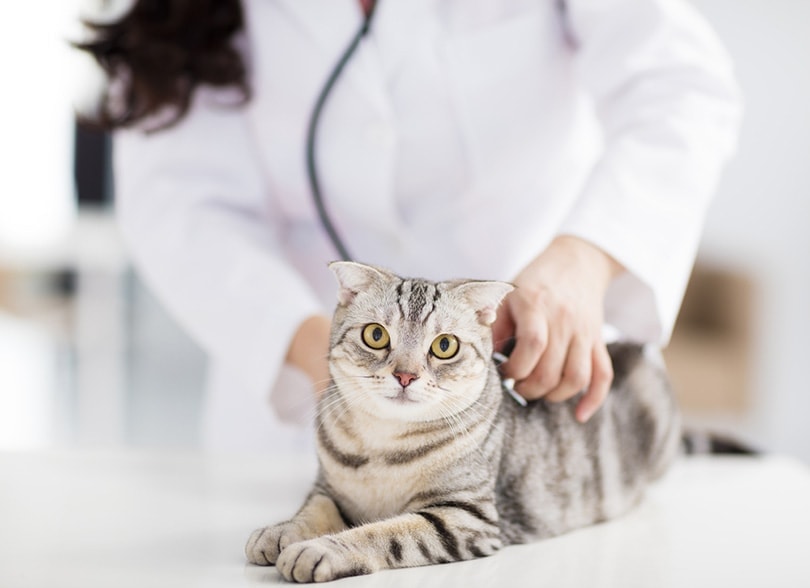Can Feral Cats Become House Pets? Vet-Reviewed Info & Considerations!

Updated on

Feral cats, which is another name for members of a domesticated species that have gone back to living as wild animals, might look a lot like an ordinary house cat, but they’re not. Many cat lovers might have found themselves wondering if they can be tamed and ultimately welcomed back into a loving home.
Information about this topic can be confusing, with some sources saying no, and some saying yes. But the answer is a complicated one. So, yes, while feral cats can become house pets in some circumstances, there are some things you will need to take into consideration.
The 3 Differences Between Stray Cats & Feral Cats
First, it’s important you recognize the difference between a stray cat and a feral cat, as it’s often difficult to tell at first glance. Both also may act similarly and seem skittish when you first approach them, but ultimately a feral cat is going to be the most difficult one to domesticate. So, what is the difference between them?

1. Socialization
Feral cats probably won’t have had much experience with humans and are generally born in the wild. On the other hand, stray cats have often been socialized to some degree.
2. Behavior
Stray cats might take on some feral qualities as they struggle to survive in the outside world, but their behavior will also depend on their surroundings. Strays may have been pets in the past, and they might have some memories of humans looking after them, feeding, and loving them, and they might stay close to homes and other places people tend to be. Feral cats won’t be familiar with life in a home with humans or other pets, so it’s going to take them some time to trust you. Depending on the personality of the cat, some feral cats may never truly trust humans.

3. Health Care
Stray cats might have been neutered and have received some health care in their lives. Interestingly, many strays look worse than feral cats, as the stress of losing their owners often takes its toll. Conversely, feral cats are accustomed to a life without human companionship. Nonetheless, a feral cat may still be carrying some diseases they can pass on to humans and other animals. They could spread ringworm, parasites, and other infectious diseases (such as cat scratch disease) that could infect people and pets.
We advise that you think seriously about whether this is a task you can safely take on. It is possible to tame a feral cat, but you will need a great deal of time and patience. In addition, success isn’t guaranteed as some cats (as mentioned above) may never truly accept human companionship.
Please Note
In some parts of the world, it’s very difficult to distinguish between a stray and feral cat, as local populations may be very comfortable with human interactions and lose their inherent fear. Taming such cats is generally very easy. However, it should be noted that a cat’s friendliness doesn’t render them safe from a public health perspective.
Cats have, on occasion, passed on rabies to humans. If you live in a rabies endemic region or country, it is VERY important to leave the management of feral or stray cats to the appropriate authorities. In addition, you should be mindful of news events mentioning any recent outbreaks.
What Should Your Next Steps Be With a Feral Cat?
So, you’re certain about taking on this task but unsure where to start. You’ll need to maintain a safe distance, as a feral cat will view you as a large predator and won’t think twice about biting, hissing, or even attacking you if they feel threatened. If the cat looks sick, it’s also wise to keep your distance and call local animal control for appropriate advice. Above all, set your expectations; this could take several weeks or longer, especially if the cat is skittish.
1. Establish a Routine Around Food
Several factors will determine the success of taming a feral cat, such as the personality and age of the cat, as well as the experiences it’s had on the streets or with other humans. But you have something that will greatly increase your chances with a feral cat: food. You can establish a feeding routine and provide meals at the same time every day to build trust with the cat.
Make sure when you do this not to make eye contact, as this can be perceived as a threat. Remain quiet, but stay in the general vicinity while the cat eats. You can then build up to speaking to the cat in a reassuring, calm voice.
Please be mindful that in some jurisdictions, feeding feral animals is strongly discouraged. For example, the AVMA doesn’t recommend feeding feral cats for public health reasons. Feeding feral cats without any intention of adopting, neutering, or rescuing them is considered counterproductive, as the animals will continue to reproduce in the area while still facing the many struggles of being feral. Feeding feral cats with the intention of rescuing them is considered acceptable in most instances. However, feeding feral cats with no intention of providing them with a better future is considered counterproductive to animal welfare.

2. Go Slow, and Don’t Make Any Sudden Movements
If the cat looks like it’s beginning to let its guard down (like it lingers after each meal and doesn’t dart away when it’s finished), you could try moving the food closer to you each day or offering some treats with the meal. Be careful not to touch the cat until you’re sure your touch will be accepted. If the cat appears very sickly, has weird bumps, lesions, or marks around their body, smells exceptionally bad, or appears to be bleeding without any feasible explanation, then you should not attempt to touch the cat and should instead contact the relevant authorities in your jurisdiction that handle such animals. When it comes time to reach out, keep your movements slow, and if the cat backs away from you, don’t try to force the introduction; instead, leave it a few days before trying again.
When you hold out your hand, allow the cat to sniff your fingers or the back of your cupped palm. As the cat learns to trust you, you can pet it if the cat accepts your presence and company. Remember to wash your hands and arms after handling a feral animal. Any food bowls you use to feed feral animals should be thoroughly cleaned and disinfected after each use and shouldn’t be used to feed any other pets you have.
3. Take the Cat to the Veterinarian
It might feel like the next step is flinging your door open and welcoming your cat to its new home, but next, you must take the feral cat to the veterinarian. This is particularly important for your other pets or if you have children. A vet will do a complete checkup, establish a vaccination and parasite control program, and administer any other medical treatments the cat may require. For everyone’s safety, it is important to place the cat in a secure yet comfortable cat carrier while transporting them to the veterinarian.

4. Introduce Your Feral Cat to Its New Family Slowly
Once your vet has given you the all-clear, you can welcome your cat into your home. You will need to set up a secluded, comfortable, quiet area for your new cat. You can stock it with feline essentials, like a cat bed, cat trees, litter boxes, and toys so that they can feel more comfortable in the new surroundings. It may take the cat a while to relax; the sound of a doorbell or a washing machine might be normal to you and your other pets, but it won’t be to a feral cat.
If you have other pets, introduce them to one another slowly. It is best to start by restricting the new cat to a single room in your house for a period of at least 2 weeks. Remember that this isn’t punishment; the cat still needs food, water, toys, a safe place to sleep and rest, and human interaction. This quarantine phase is important to ensure that your new cat doesn’t inadvertently pass something to your existing pets. You should also be mindful about your personal hygiene at this point. After interacting with one cat, you should thoroughly disinfect yourself (especially your hands) before interacting with another cat.
Following the quarantine period, you should place your existing cat in the room (again, this isn’t punishment) while you allow the new cat to explore the rest of the house and interact with the scents they find. Remember to not share food bowls, litter trays, beds, etc. among the cats at this point. Pay close attention to each cat’s body language as they explore the scents of the other cat. If they are skittish, shy, or react in an unpleasant way to the scents they pick up (for example, if they go into hiding or begin spraying), you may have to ask a professional cat trainer for assistance.
If the scent introductions seem fine, you can attempt a physical introduction by placing one cat (usually, the one you fear might be more aggressive) in a crate and allowing the other cat to approach them on their own terms, under your supervision. Observe their body language and don’t force an interaction if the cats don’t appear to be amicable.
If the cats seem to enjoy each other’s presence, you can attempt introductions without a crate, for a limited amount of time, under your supervision. Depending on how well the cats get along, you can slowly begin increasing the duration they spend together. It is advised to supervise all interactions for at least a period of a few weeks, increasing the duration each time, to ensure your cats are comfortable with each other.
Final Thoughts
Feral cats can become house cats, but it is not a journey that the faint of heart can take on. It will take a lot of patience and time to build a relationship with a feral cat, and there is also the chance that it might not work out. Wild animals are unpredictable, and many, especially feral cats, have lived miserable lives without experiencing how humans can benefit them. Giving a feral cat a new home can be rewarding, but you must prioritize keeping everyone safe, including the cat, especially if you have children or other pets.
Featured Image Credit: katrin88888, Shutterstock










